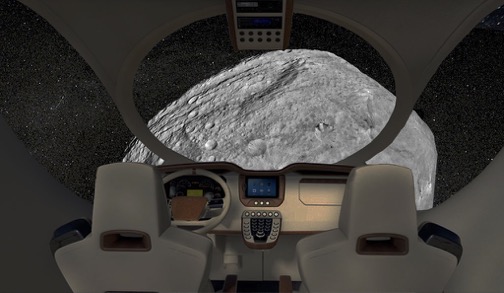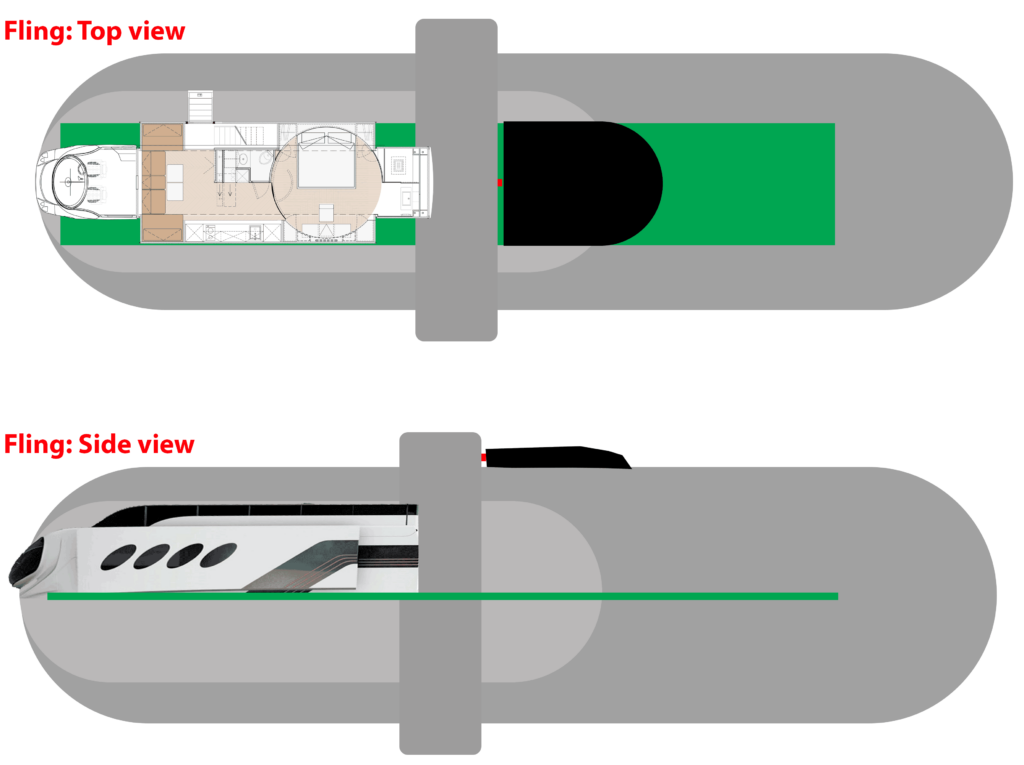Slingship Sam chapter 5
Sam woke in darkness. His head hurt. He was floating in zero gravity, and that was not good. The interior of the spaceship was dark, lit only by the stars and the dim reflection from low-albedo asteroid Hilco shining through the windshield.
“Fling?” he said. “What happened? What’s going on?” The asteroid filled most of the viewscreen and was slowly shrinking as the slingship moved away.

There was no answer. He listened and except for the faint harmonic hum of the mag drive, he heard nothing, not even the subtle whirr from the life support system. Dead silence.
“Fling!”
Still no answer. Sam tried to remember the emergency power sequence…Fling always took care of everything according to Sam’s voice commands. This time he had to do it himself. The emergency power reset switch was in the overhead panel, that was right; he’d never had to use it before. He unstrapped and floated up and pushed the switch.
He heard a thunk from the emergency power system in the rear of the slingship. The interior lights flickered and came on dimly. The life support system’s ventilators resumed moving fresh air. The internal gravity came back on and Sam’s butt settled back down into the seat. Visual overlays returned to the windshield and displayed windows of menus. “What the heck happened? Fling! Are you back yet?”
There was no reply. “God damn it.” He touched the windshield’s control patches and was able to bring into view a list of powered systems. He clicked off all communications and housekeeping systems, plumbing control, attitude control…as he clicked off each system, the lights began to brighten and the annoying hum of the emergency power system relaxed its intensity.
Fling said, “Systems are now being monitored and optimized.”
Sam said, “Fling! What happened?”
“Asteroid Hilco unexpectedly contains large amounts of highly magnetic material. The energy transfer overloaded the ship’s systems in an unknown manner. We are now in a derelict orbit around Hilco.
“The magnetic drive is operative. It is absorbing solar-field energy and adding it to internal battery storage, but the drive cannot access the main propulsion battery.”
“You mean we’re stuck here?”
“Yes.”
“What happened? What went wrong?”
“The point of failure is unclear,” Fling said.
“What’s our situation? What kind of orbit are we on?”
“A nine-hour elliptical orbit around Hilco, ranging from 100 miles to 1 mile.”
“But the mag drive is working?”
“Yes. The mag drive remains in full operation.” On the windshield, Fling showed a view from one of the external cameras. Sam saw that the ship was still surrounded by a magnetic bubble of writhing aurora colors, still absorbing energy from the solar wind and the solar electro-gravitic field, still protecting the ship from radiation.
“So why are we stuck?”
“The magnetic drive cannot access the main propulsion battery.”
“Show me the main propulsion battery.”
“The camera with a view of the battery is transmitting no images.”
“Show me the exterior of the ship from the cameras that are still working.” Fling had ten external cameras: one at the front, one at the rear, four on the front side of the mag drive, and four on the aft side. Fling presented 10 video windows and one of them was blank. The others showed the outer hull, a cylinder like a giant SCUBA air tank. There was no view of the mag drive because the cameras were mounted on it. The metal torus of the mag drive wrapped around the middle of the hundred-foot long capsule. Everything looked normal from the remaining cameras.
“Show me a replay of the battery before the cameras went out.”
The blank window flickered and changed to display the main propulsion battery. It was three feet thick and ten feet wide and twenty five feet long, curved to fit precisely onto the spun-carbon hull. The video showed nothing happening. Then there was a flash of light, and the video went black.
“The camera reports as operational but is receiving zero photons,” Fling said.
“What could have happened? Did we hit something? Did the asteroid launch something against us?”
“The dysfunction occurred at the moment of periapsis and highest acceleration. All sensor data ceased at that moment and did not resume until your reset.”
“Show me the asteroid during our approach.”
Fling presented a video showing the asteroid growing bigger and bigger in the viewplate. Only the sunlit half was visible. They were at closest approach for less than a second, and then the view from all cameras went black.
“Show me again, but real slow this time.”
Slowing it down didn’t help. The rock slid slowly underneath and appeared to rotate, but it was an illusion caused by their close approach and orbit. It looked like Phoebos, the port at inner Mars orbit, or any other asteroid: dark, and pocked with craters. The frame rate was too slow to catch much detail at their high speed: everything was blurry and jerky despite Fling’s optimization of the video data. And then it went black.
Sam dismissed the video and looked at Hilco looming in the windshield. It looked about as big as a watermelon held in your outstretched hands. “We’re in orbit, right? When is our next closest approach?”
“In eight hours and twenty three minutes.”
“Let’s go back to the battery camera. Show me again but slow it way down.”
The slowed-down view of the main propulsion battery didn’t look any different, it just took longer to get to the flash and the subsequent darkness.
Sam said, “Do you have a further update on possible causes?”
“It’s as if the battery is no longer physically present,” Fling said.
That wasn’t good. If the battery was vaporized, he was doomed.
“Okay. We’d better go out and take a look at the battery.”
Sam called Patroclus and said, “Hello Patroclus , this is Sam again, I’ve been slightly delayed. My mag drive has malfunctioned at Hilco and I’m now stuck in orbit here. I’m about to make a space walk to inspect the damage. More later, Sam Flandern out.”
He didn’t wait for a reply. Patroclus was 387 seconds out of Now with Sam, plus it was six in the morning there.
Hilco was inside Sam’s Now. He told Fling, “Keep hailing Hilco and try to get a response.”
He went to the airlock door and grabbed his vacuum suit off a hook. He pulled it on over his cargo shorts and t-shirt. It was a tailored transparent graphene fabric that clung to him like a full-body nylon stocking. He carried the clear helmet and airtank assembly under his arm as he went through the airlock into the pressurized cargo hold.
The Palazzo Superior motor home was inside a titanium capsule that included the life support system, and the capsule was inside a still larger layered graphene capsule with storage, cargo area, and the mag drive.  As long as Sam had energy from the mag drive he could recycle the air and food endlessly, if necessary. He could live on one batch of chem indefinitely, but it sure began to stink after a while. Back on Interamnia, he dumped it whenever it started to get rank, but on a long interplanetary trip there was no way to refresh the chem tank.
As long as Sam had energy from the mag drive he could recycle the air and food endlessly, if necessary. He could live on one batch of chem indefinitely, but it sure began to stink after a while. Back on Interamnia, he dumped it whenever it started to get rank, but on a long interplanetary trip there was no way to refresh the chem tank.
He grabbed a spare external camera module from a locker in the storage area. They were the size of a golf ball cut in half. At the exterior airlock, he put on the helmet, closed the interior door, connected the safety line to his belt, opened the exterior door, and stepped out into space.
The ship’s artificial gravity did not extend out to here. Sam grabbed handholds and pulled himself along Fling’s outer hull, a hundred-foot-long tube of spun carbon, to the mag drive, which was a torus of metal, a donut wrapped around the midsection of the tube.
The battery was on the other side of the mag drive; Sam floated over the curve of the mag drive and saw the battery and felt a surge of relief: the battery was intact.
“Your helmet camera shows that the corium connector rods are gone,” Fling said. Fling had sharper vision than Sam.
He moved closer to the battery and saw what Fling was talking about: the corium rods between the battery and the drive ring were gone.
“It is likely that the unexpected influx of energy from the deceleration at the asteroid overloaded the rods,” Fling said. “They reverted to normal iron and vaporized.”
There were two rods between the battery and the mag drive, an anode and a cathode. Both of them were vaporized. Sam said, “I thought corium was a superconductor, how could this happen?”
“There is no record of similar instances of failure,” Fling said. “It’s a quite unlikely event.”
“Lucky me,” Sam said. “There’s no reports because the ships died. Just like we’re going to.”
“You’ve survived so far despite your proclivity for risk,” Fling said.
“Thanks for trying to cheer me up.”
Sam moved to the location of the disabled camera on top of the magdrive ring, and immediately saw the video problem: the camera was coated in a silvery sheen: iron residue condensed from the evaporated corium.
He replaced the camera and came back inside the ship.
Sam peeled off his vacuum suit and hung it at the airlock door. It was good to get back into the artificial gravity again.
“Do we have enough corium to make a new set of connector bars?” he said as he headed back through the motor home to the driver’s seat.
“We do not have any corium on hand,” Fling said. “Perhaps we could acquire sufficient corium from Hilco.”
“Do we have any response from Hilco?”
“No. But there is a fresh reply from Patroclus .”
Timmins, that’s right. “Sorry to hear about your plight, Sam,” Timmins said. “It is not within Patroclus Control’s power to do any kind of rendezvous or rescue for you, etc etc, you’re on your own, Sam, sorry. We were unable to ascertain what Hill Corporation was doing. It looks like another attempt to make a large scale delivery of an entire iron asteroid to a NASA processing center.
“But we don’t know. They didn’t file a flight plan, and NASA has no record of any information from Hill Corporation since its inception. We still haven’t located the iron, Hilco B–not that it’s a high priority. Good luck, Sam.”
“Message to Patroclus ,” Sam said. “Thanks for looking into it for me, Bill. I’ll let you know when the situation changes. Sam Flandern out.”
Sam stared at the asteroid slowly dwindling in the viewscreen. “Now what?” he said.
Fling said, “There is still no response from Hilco. It appears that the asteroid has been abandoned. We cannot make further assumptions until we inspect the surface at periapsis in seven hours and forty two minutes. All life support systems are nominal and secure. You should get some sleep.”